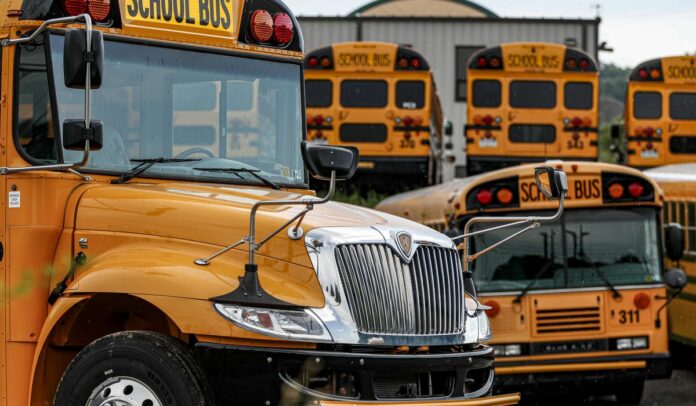Getting children to school on the big yellow bus might be the biggest headache facing administrators when classes begin this fall.
Aging drivers, few replacements and multiple routes to meet social distancing rules are confounding school districts trying to arrange for student transportation while COVID-19 continues to spread.
In Texas, 80% of school bus drivers are senior citizens with increased risks from COVID-19, and many are considering not going to work in the fall.
In Jacksonville, Florida, the public schools superintendent said compliance with social distancing guidelines will require busing children to and from campuses for 10 hours — each day.
“When they are seated on the bus, they will be required to wear a facial covering because we cannot create that social distance of 6 feet,” Superintendent Diana Greene said Tuesday in a message to parents.
Jacksonville schools also are requiring children to sit in assigned seats on specific buses.
One Virginia school district is scrambling to find bus drivers after holding a job fair that attracted … no one.
“It’s not looking good [at filling vacancies],” said Beverly Young, transportation director for Suffolk Public Schools.
But for any would-be driver concerned about buses packed with children who could be carrying the coronavirus, Ms. Young has a message: “They’re thinking about a busload of kids. They’re not going to have that this time.”
About 210,000 bus drivers are employed directly among 130,000 school districts across the country to transport about 15 million children each school day. Some drivers are leery about returning behind the wheel as COVID-19 cases increase in several states and counties.
Shane Johnson, chief operations officer for Palmer Bus Service in Minnesota, said he has not heard about any of his roughly 1,000 drivers who have balked at coming back because of the virus, but he added that the perennial bus driver shortage will be more trying this year.
“Is it going to be a little bit more this year? More than likely, yes,” said Mr. Johnson, whose company contracts its 600 buses with two dozen districts around Minnesota.
Safety protocols that Palmer Bus Service will employ are still being discussed. Minnesota Gov. Tim Walz, a Democrat, has yet to provide guidance about the school year, which begins after Labor Day.
Other school districts are only a few weeks from starting the year and have plans in place. In Suffolk, Virginia, the district’s 150 buses will operate at 50% capacity along 114 routes. In San Antonio, cellophane wrapping will guide children to their seats.
Meanwhile, fears about an outbreak persist in places including Fayette County, Kentucky, where nearly two dozen employees at a bus garage contracted COVID-19 and one died.
“I want to get back on that bus every day,” Jerry Boyce, a bus driver in rural Oregon, told The Hechinger Report. “But there’s no point in rushing things if it’s going to kill a bunch of people.”
Safety guidelines from the Centers for Disease Control and Prevention include wearing masks, alternating students in seats and installing plexiglass barriers. But these protocols vex school officials already strapped by looming budget cuts.
In Idaho, many districts struggled to fill fleets of bus drivers before COVID-19 and the governor’s $99 million cut to the education budget.
In New York City, officers with a union representing bus drivers lament that the crunch on busing comes amid rhetoric supporting front-line workers.
“You’re calling us heroes. We’re coming to work. Many of our drivers have passed. Thousands were quarantined,” said John Costa, president of the Amalgamated Transportation Union International, representing nearly 200,000 members of transit employees, including school bus drivers.
In Philadelphia, vacancies for bus drivers stand at 98, and finding drivers plagued the district before the onset of COVID-19.
“We are challenged to fill bus driver vacancies,” said Monica Lewis, a spokeswoman for the Philadelphia School District, adding that most large districts are facing those same challenges.
Many drivers fear that children, who can be asymptomatic carriers of the coronavirus, will transmit the virus to them.
Three out of four part-time school bus drivers are older than 55, compared with less than 20% of classroom teachers, according to AARP. Many school districts say they will take precautions to sterilize buses with industrial disinfectant twice a day, require mask use for drivers and children, and place one child per row (save for siblings).
But drivers want more requirements: parents wearing masks, better air circulation and training. Some safety thresholds urged by the CDC, such as mandating temperature checks before boarding the bus, can stymie drivers.
“If you have kids on the bus, a driver can’t get off the bus to start taking temperatures,” Michael Cordiello, president of American Transportation Union Local 1181 in New York City, told The Washington Times.
Installing an aide on each bus in a fleet would cost districts approximately $384,000, according to a report from the Association of School Superintendents and the Association of School Business Officials International.
“I don’t think it’s impossible [to bus kids safely], but a lot of work has to be done,” Mr. Cordiello said.
The silver bullet for many drivers could be staggered in-person learning days for districts. In Utah, state officials said if they transition into a more lenient phase allowing for in-person learning, students will report to physical campuses only once or twice a week, depending on their age.
School districts in New York, West Virginia, Colorado and Florida also have implemented or are considering staggered cohorts of in-person learning.
But many transportation directors and bus drivers keep waiting to find out what their job will look like, as does the rest of the academic world, as the countdown to the opening day begins.
“This is all so fluid,” said Ms. Young, who noted the plan in Suffolk is to mask drivers with aides on special education vehicles wearing face shields, as well. “I could tell you what it’ll be, but it might change 20 minutes from now.”






